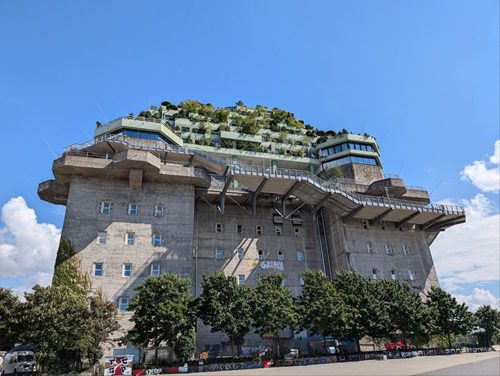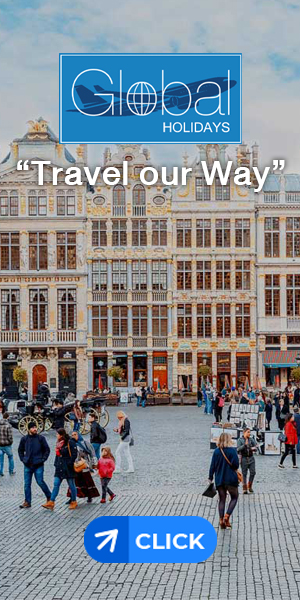 A World War II bunker turned into a hotel, a food hall filled with locally grown vegetables, and vast stretches of ambitious green spaces that tourists are helping keep clean.
A World War II bunker turned into a hotel, a food hall filled with locally grown vegetables, and vast stretches of ambitious green spaces that tourists are helping keep clean.
Those may not be the first things you think of when you come to a place like Hamburg — a German port city known for its vast network of canals and tasty Fischbrötchen, or fish sandwiches.
But this summer, just as the European soccer championship wrapped up, two new sustainability-minded attractions opened in Hamburg. They complement the city’s worldwide reputation for parks and green spaces, which the government is now nudging with an unexpected tourism angle. (Hamburg already has far-reaching sustainability goals outlined in its Agenda 2030 plan.)
Together, these developments speak volumes about Germany’s commitment to sustainability in tourism. They’re diverse and creative, perhaps even a little unorthodox. And they’re off to a promising start.
A view of the roof garden at the top of the bunker with Hamburg’s iconic Heinrich-Hertz-Turm, a television tower, behind it. The roof garden is accessible to the public.
A new hotel in the Grüner Bunker.
One of Hamburg’s newest sustainable attractions, opened just last month, is the Reverb by Hard Rock Hotel, a property built on top of a World War II-era bunker in the trendy St. Pauli neighbourhood.
The bunker has a colourful past. It was built during World War II to shelter Hamburg residents from air raids, but after the war, it fell into disrepair and was reimagined as residential units and then office space. Finally, its owners redeveloped the bunker into a multi-use facility with offices, a new purpose-built hotel, and Hamburg’s highest roof garden.
Constanze Döbber, the marketing manager for Reverb—or simply the Bunker Hotel, as many here call it—says the hotel is serious about living up to its name.
“We feel a sense of responsibility here when it comes to sustainability,” she says.
There’s more to the hotel than a roof garden, which is open to the public during the day. Researchers from the University of Hamburg are also conducting environmental research at the bunker, where you can see the measurement stations at various locations on the roof. Döbber says she hopes they will lead to a better understanding of how plants grow in a dense urban environment.
The hotel also has a unique contract with the city that allows its meeting space to be used by a local school during the week. That ensures the facility is always busy and rarely sitting idle.
The bunker has become a transformed space, from a local eyesore to a green pyramid, one of St. Pauli’s most recognized landmarks. On a recent summer day, the bunker was practically unrecognizable after its 20th-century greyness, with trees and shrubs sprouting from the room like a modern-day Hanging Gardens of Babylon.
But it’s not the only place in Hamburg where people pursue sustainability.

Axel Ohm, managing director of Le Big TamTam, a new food hall in Hamburg that features local restaurants and has a strong sustainability focus.
A “completely different” food hall in Hamburg
In Hamburg’s bustling Hanseviertel district, deep inside an indoor shopping mall, a new kind of food market with a sustainability emphasis opened in July.
“We wanted to do something completely different,” says Axel Ohm, managing director of Le Big TamTam, a new food hall in Hamburg featuring local restaurants and a strong sustainability focus. “We’ve opened food stands here, which are all from local restaurants.”
Being local is part of the sustainability equation, of course. However, the six restaurants in TamTam’s roundabout also offer an exceptionally green menu. Not only are the items locally sourced, but there are also many plant-based offerings. For example, ÜberQuell, the food court’s pizza joint, offers several types of vegan pizza, including a tantalizing “garbage” pizza with red beets. (That’s an “only in Germany” moment.)
Ohm, who also owns ÜberQuell, says sustainability has been a centrepiece at their flagship location in St. Pauli.
“We have a farm on the property where we grow some of the ingredients for our pizza,” he explains. We work with local school groups to harvest the vegetables and herbs and then use them at the restaurant.”
Ohm says TamTam’s focus has been on sustainability from the moment the food market’s five business partners hatched the idea. TamTam wanted to go contrarian — where other food markets were bringing in chain restaurants or standard fare, they sought to take visitors worldwide with a distinctive Hamburg flair.
And thanks to local sourcing initiatives, Ohm says the entire operation is more sustainable, too.
Hamburg’s “green kayaks” are free — but there’s a catch.
It’s one thing to make your operation more sustainable by adjusting your menu or building a roof garden. But what if you could make the whole thing more participatory? That’s the idea behind Hamburg’s “green kayaks,” a project funded by the city of Hamburg that allows visitors to see the city’s waterways for free.
But there’s a catch, explains Tobi Hatge, a manager at SUP CLUB Hamburg along the city’s Isebekkanal.
“You can rent the kayak for anywhere between an hour and a half and two hours, and it’s free of charge,” he says. “But you have to collect some trash and bring it back.”
Although Hatge’s club’s program is limited to two days a week, he says that since the season began in late May, his visitors have already collected more than 300 pounds of trash from the nearby rivers and canals.
“It’s very good for the environment,” he adds.
It’s also good for price-conscious visitors who want a cheap adventure on Hamburg’s waterways. Hatge says people don’t mind collecting trash; it gives them a sense of accomplishment that they’ve done something for the planet.
Behind the scenes, Hamburg is working to upgrade its image from a historical port city to a green trendsetter. There’s evidence that rehabbed bunkers and clean canals are having the intended effect.
“When people visit, they want to move here,” says Julia Bankus, a spokeswoman for Hamburg Tourismus, the city’s destination marketing agency.
That may be the highest praise for any city and the ultimate endorsement of Hamburg’s sustainability ambitions.
Written by: Christopher Elliott
BIO:
Christopher Elliott is an author, consumer advocate, and journalist. He founded Elliott Advocacy, a nonprofit organization that helps solve consumer problems. He publishes Elliott Confidential, a travel newsletter, and the Elliott Report, a news site about customer service. If you need help with a consumer problem, you can reach him here or email him at chris@elliott.org.


















